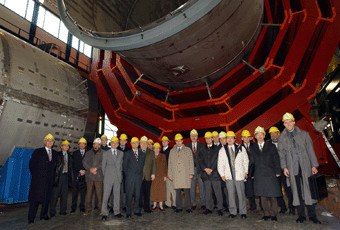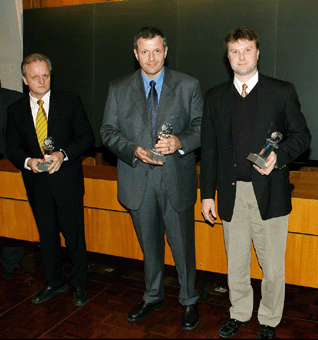
The winners of the third CMS suppliers' awards visit the assembly site for the detector.

The winners of the third CMS suppliers' awards visit the assembly site for the detector.
Unsurprisingly, the CMS magnet was once again in the limelight at the third awards ceremony in honour of the collaboration's top suppliers. 'Unsurprisingly', because this magnet, which must produce an intense field of 4 Tesla inside an enormous volume (12 metres in diameter and 13 metres in length) is the detector's key component. As a result, many firms are involved in its construction.
The CMS suppliers' awards are an annual event aimed at rewarding the exceptional efforts of certain companies. Firms are only eligible once they have delivered at least 50% of their supplies.
This year, the collaboration honoured eight firms at a ceremony held on Monday 4 March in the main auditorium. Seven of the firms are involved in the construct\ion of the magnet. Three of them - Outokumpu Pori Oy, Nexans Suisse and Plascore Inc - received the highest distinction - the Crystal Award - for their work, deemed to be exceptional. The five others received the Gold Award.
Outokumpu Pori Oy is the Finnish company supplying superconducting strand, the basic comp\onent of the CMS magnet coil. Indeed the coil cable, known as 'Rutherford cable' comprises 32 conductors, each made up of 600 superconducting strands. The quality of these strands is essential to producing the intense magnetic field. It took several years of research to arrive at the best formulation. In the final design, the strands are 1.28 mm in diameter and made of a niobium-titanium alloy coated in a copper matrix. The critical current density of each strand is more than 300 amperes per square millimetre! Needless to say, finding a company capable of producing 2000 kilometres of such wire was not an easy task. But CMS did manage to find that rare pearl, the firm Outokumpu Pori Oy, which succeeded in producing the strands to specification. By the beginning of 2002, the Finnish company had delivered 1400 kilometres of strand, corresponding to 70% of the order.
The second Crystal Award went to the company Nexans Suisse, which makes its contribution at a later stage in the production of the superconducting coil. The Rutherford cable must be sheathed in extremely pure aluminium in order to pr\oduce the 'superconducting insert'. To achieve this, Nexans Suisse, in collaboration with the Eidgen?ssische Technische Hochschule ETH in Zurich, has developed a special extrusion process, since the Rutherford cable cannot be exposed to temperatures of more than 400 C for longer than one minute, otherwise its superconducting properties risk being degraded. Moreover, in collaboration with Swiss firm EMPA, the company has developed a quality control procedure, proven to be excellent. By the end of January, Nexans had already supplied two thirds of the 2600 m long inserts.
Three other firms - Brugg Cables, Sumitomo Chemicals and Alcan - all involved in the manufacture of the coil received the Gold Award. Swiss firm Brugg Cables is responsible for producing the Rutherford cable, Japanese firm Sumitomo Chemicals produced the highly pure aluminium (99.9998% purity) essential for sheathing the cables, while another Swiss company Alcan supplied a high-quality aluminium alloy to reinforce the superconducting insert. These reinforcements offset the intense magnetic forces to which the coil is subjected. The five companies involved in the manufacturing of the superconducting coil would not have achieved these performances without the help of physicists and engineers from CERN, Fermilab and the Eidgenssische Technische Hochschule ETH in Zurich.

A. Ingman of the Finnish company Outokumpu Pori Oy, F. Kruhenb of the Swiss firm Nexans Suisse and M. Niemerski of the American company Plascore receive the highest distinction of the CMS suppliers' awards, the Crystal Award.
Two other recipients of the Gold Award have been working on the magnet yoke, namely French firm Andr? Laurent, which manufactured special prestressed tie-bars to ensure rigid assembly of the yoke rings, and German firm Noell Konecranes, which produced the air-pad systems that allow the heavy yoke components to be moved around the detector work-site.
The eighth company honoured last Monday, Plascore Inc, is the exception as it is not involved in the construction of the magnet but that of the endcap muon chambers. The American firm produced the key components for these structures, namely the panels, which comprise a honeycomb-structured polyester layer sandwiched between two sheets supplied by Fermilab. The quality of these panels is crucial to the proper operation of the cathode strip chambers. Plascore produced 2000 of these on schedule and in compliance with the extremely demanding specifications and thus received the highest distinction, the Crystal Award, for its exemplary work.